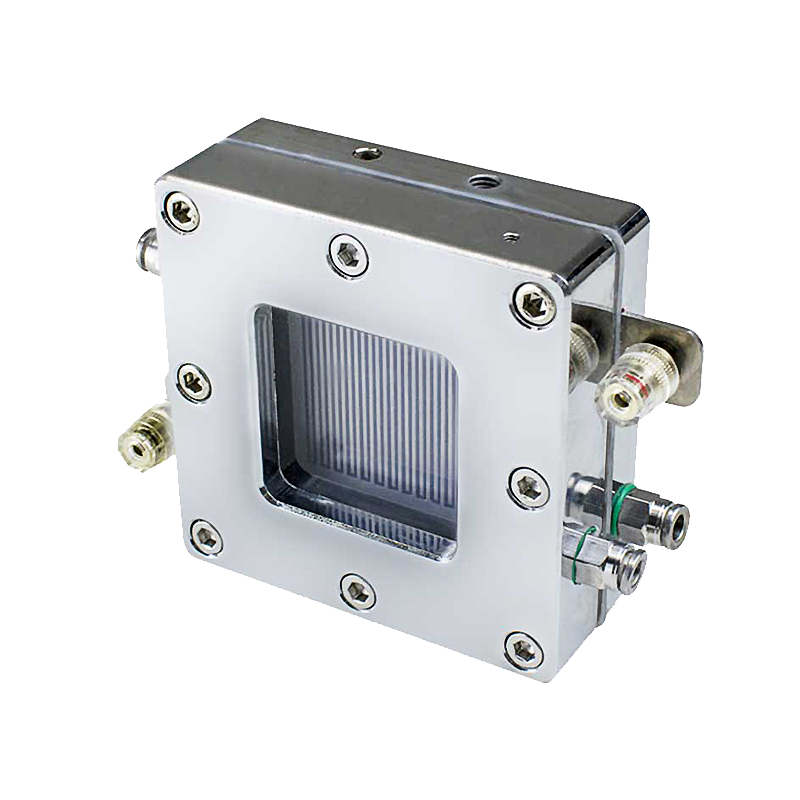An electrolyzer is a device that converts electrical energy into chemical energy by electrochemically splitting water into hydrogen and oxygen. It is a key technology for achieving green energy conversion. This article will explain the working principle of electrolyzers in simple terms and introduce how the related products from Beijing Porfire Technology Co., Ltd. support the research and application of this process.
The basic principle of an electrolyzer is similar to the reverse process of a battery: when external electrical energy is applied to the electrodes of the electrolyzer, water (H₂O) undergoes an electrochemical reaction under the action of a catalyst, producing hydrogen gas (H₂) and oxygen gas (O₂). Specifically:
Cathode reaction: Electrons flow from the power supply into the cathode, where hydrogen ions (H⁺) in water gain electrons and are reduced to hydrogen gas (2H⁺ + 2e⁻ → H₂).
Anode reaction: Electrons flow out from the anode, and water is oxidized to oxygen gas (2H₂O → O₂ + 4H⁺ + 4e⁻).
Throughout this process, electrical energy is converted into chemical energy stored in hydrogen gas, enabling clean energy production. The efficiency of the electrolyzer depends on factors such as electrode materials, electrolyte type, temperature, and pressure. For example, using efficient catalysts (such as platinum or nickel-based materials) can reduce reaction energy consumption and increase hydrogen production rate.
Electrolyzer technology is widely applied in hydrogen production, energy storage, and industrial synthesis. However, challenges remain: low reaction efficiency, bubble accumulation causing increased resistance, high sealing requirements for the system, and stability issues during large-scale application.
Beijing Porfire Technology Co., Ltd. provides specialized solutions addressing these challenges, highlighted by high sealing performance, flexible design, and energy efficiency optimization.
PLS-MECF Series Laboratory Electrolyzer:
This product adopts a double-seal design to ensure no leakage in the cell body, suitable for harsh reaction conditions (such as acidic or alkaline systems). Its flow plates are made of titanium alloy with strong corrosion resistance and support multiple flow channel types (serpentine, parallel channels, etc.) to optimize fluid distribution and reduce bubble accumulation, thereby lowering resistance and improving electrical energy conversion efficiency[3]. The electrode active area is customizable (from 1 × 1 cm to 5 × 5 cm) to meet experimental needs with different catalyst amounts, helping researchers finely tune reaction parameters.

Ultrasound-Coupled Dual-Chamber Electrolyzer Device:
This innovative product integrates ultrasonic technology with electrolyzer technology. Ultrasound, as a non-contact external field, provides continuous energy input and eliminates bubbles on the electrode surface through cavitation, reducing resistance while generating localized high temperature and pressure to enhance reaction efficiency. For example, in electrocatalytic water splitting or CO₂ reduction, the ultrasound power is adjustable (0-60 W) and paired with real-time temperature monitoring to ensure stable reaction operation[1]. This coupled design significantly improves electrical energy conversion efficiency, suitable for both research and industrial applications.

Electrolyzer electrical energy conversion technology is at the core of the hydrogen economy. Porfire Technology’s products, through precise design and innovative integration, help researchers overcome efficiency and stability bottlenecks. With the growing global demand for clean energy, such tools will accelerate the industrialization of electrolyzer technology and support the achievement of the "carbon neutrality" goal. In the future, electrolyzers may become standard equipment in homes and industries, and their development begins with every clever conversion of electrical energy in the laboratory.
Recommended
news